
PGA players rely on one particularly invaluable tool—perhaps above any other—for acing each swing and upping their overall game, and his name starts with “Coach.” But despite the omnipotence of swing coaches today, coaching in general is relatively new to the golfing world—one factor that significantly separates us from other like-structured professional sports like tennis and cricket.
Since the early 70’s, however, the role of swing coaches at the game’s most professional level has been on a pretty consistent rise.
When Tiger Woods switched from veteran coach Sean Foley to relative newcomer Chris Como last fall, the announcement made sports headlines around the world. Years earlier, Tiger created similarly large-scale media buzz over his break-up with his longtime PGA partner Butch Harmon. Both of Tiger’s former teachers are still regarded among the top swing coaches in the PGA.
For the average non-pro player, of course, hiring coaching services of such caliber isn’t much of an option—easily costing upwards of $1000 an hour for one-on-one training. But we’ve got the next best thing for helping you master the art of a master-level game.
Here’s a quick rundown of the training philosophies held by five top PGA swing coaches:
Butch Harmon : Sound Takeaway and Swing Width
 Image Source: http://www.golfncpinehurst.com/how-to-swing-irons-correctly
Image Source: http://www.golfncpinehurst.com/how-to-swing-irons-correctly
Tiger’s teacher of 17 years is regarded, pretty universally, as the top swing coach in the PGA. Before that, he held the respectable rank of the world’s best junior golfer as well as Champion of 39 total PGA Tours.
As a coach, Harmon’s philosophy can be summed up by a key focus on maintaining a sound takeaway and mastering the ability to shorten one’s swing while still maintaining excellent width and managing not to sacrifice any of the power behind it.
Harmon advocates a “compact swing,” requiring that the player’s arms stop moving at the same time the shoulders stop rotating on the backswing—a rule he says is frequently broken by amateur golfers, who tend to fold their left arms or/and over-cock their wrists. Either of those two mistakes can cause the club to dip beyond parallel, then casting it out and across the target line on the downswing, ultimately weakening the overall slice. His advice for fixing that common problem is to imagine your hands pushing away from your head on the backswing, which helps in maintaining maximum distance between the head and hands as well as keeping the arms and shoulders in sync—cumulatively a wider arc for extra distance without the slice.
Sean Foley : Zen Presence and “New Generation” Stack & Tilt
 Image Source: http://www.ruthlessgolf.com/2010/09/sean-foley-on-reducing-back-pain.html
Image Source: http://www.ruthlessgolf.com/2010/09/sean-foley-on-reducing-back-pain.html
Another former Tiger trainer, Foley is a self-taught “Golfing Machine”—who has established his own rich and comprehensive game philosophy from a variety of eccentric influences—including the diverse academic fields of both geometry and kinesiology as well as Eastern spirituality principles.
His most centralized advice is easy enough to understand and implement: he urges golfers to simply be themselves on the course. (“You can’t fake anything.”) Other pragmatic words to the wise include advocacy of skill-development via “deep practice and repetition.”
On a more technical level, Foley advocates a modified version of the Stack & Tilt method. Specifically, he stresses the importance of the following elements in pulling off the perfect swing: front-focused weight distribution at address, avoiding a dipped left shoulder and straight back leg on the backswing, significant front-forward weight shift on impact and a subsequent positional rise to perpendicular on follow through.
Hank Haney: Swing Plane Theory and Practice Drills
 Image Source: http://golfmuskoka.com/fix-your-slice-with-this-great-drill-from-hank-haney/
Image Source: http://golfmuskoka.com/fix-your-slice-with-this-great-drill-from-hank-haney/
Hank Haney is the third on our list to be a former coach for Tiger as well as to prolific PGA winner Mark O'Meara. He owns four teaching facilities in the Dallas, Tex. Area and is also known for the Golf Channel’s series The Haney Project: Charles Barkley.
His core philosophy in his own words: "To teach my students to become their own best teacher by getting them to understand the flight of the golf ball and how it relates to the swing, with emphasis on swinging the golf club on their own correct swing plane."
To that effect, Haney advocates the use of practice drills designed for mastering his swing plane approach—essential for fixing the slice problem experienced by the majority of amateurs and even some pros. The ultimate goal of his swing coaching is succinctly enough to optimize “every aspect of the swing to improve power, accuracy and consistency.”
David Leadbetter: Individuality and the A Swing
 Image Source: http://www.golfdigest.com/golf-instruction/2013-02/david-leadbetter-coil-for-power
Image Source: http://www.golfdigest.com/golf-instruction/2013-02/david-leadbetter-coil-for-power
Leading international instructor David Leadbetter, who has published numerous highly regarded books and training videos on swing technique, is known for his rather complex formulaic approach to the subject.
His core philosophy can best be summed up in his own words to Golf Digest circa 2010: “Golf swings are like fingerprints: No two are the same.”
Leadbetter is perhaps most notably hailed for his invention of the “A Swing”—‘a’ being short here for ‘alternative.’ In a nutshell, the A Swing is another option for those unable to successfully master the conventional approach. Its fundamental elements include: proper grip and athletic posture, a well-practiced pivot, sequentially synchronized positioning of the club and body—and lastly, an overall observance of the individual player’s natural rhythm.
Jim McLean : The Slot Swing and 25% Theory
 Image Source: http://www.hackersclubgolf.com/blog/#.VVpShflViko
Image Source: http://www.hackersclubgolf.com/blog/#.VVpShflViko
McLean is a former instructor from four of the country’s top private clubs and currently the owner of the #1-rated golf school in the U.S.
His core philosophy is based around the idea that there is more than one way to play—and teach—the game, with a definitive focus on individual players’ needs and abilities.
McLean is an advocate of mastering key swing fundamentals through inventive practice drills designed to instill them. His “25% Theory” is structured around unique strategies for the long game, short game, mental game and management game—it also happens to be the central teaching aspect used at his schools. Other tenets of McLean’s approach to the game include the development of a consistent swing and confident “winning attitude” to match.
His swing of choice is the Slot Swing, which essentially requires players to drop the clubshaft into an imaginary "slot box" during the mid downswing, allowing it to move along an inside-out path toward the ball.
For more tips on how to improve your swing, visit Driving Range Tips: Part One!

